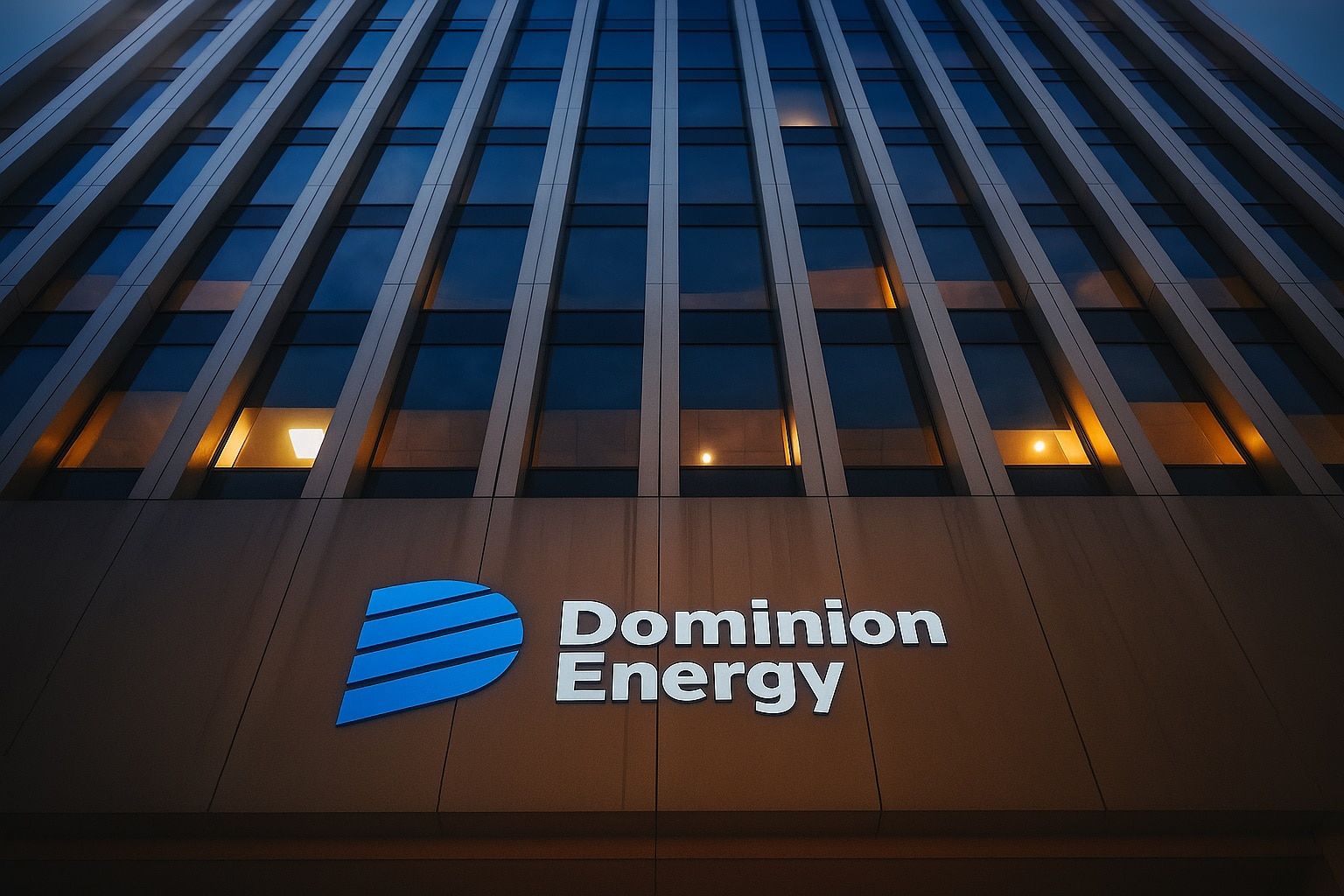- Earnings Beat: Dominion Energy topped Q3 2025 profit expectations, posting operating earnings of $1.06 per share (vs. ~$0.95 anticipated) and GAAP net income of $1.0 billion (up from $934 million in Q3 2024) [1] [2]. This marked an ~8% year-over-year EPS increase.
- Revenue Soars: Quarterly revenue jumped ~15% to $4.53 billion on strong power demand in Virginia and South Carolina [3]. Dominion’s regulated utility businesses benefited from customer growth and new rate-supported investments [4].
- Guidance Raised: The company narrowed its full-year 2025 earnings guidance to $3.33–$3.48 per share (from $3.28–$3.52), keeping the midpoint $3.40 and projecting results at or above that level [5] [6]. Dominion also reaffirmed its long-term goal of 5–7% annual EPS growth through 2029, signaling confidence in steady future expansion [7].
- Data Center Demand Boom: Dominion – the primary utility for Northern Virginia’s “Data Center Alley” – is in contracting stages to supply a staggering 47 GW of new data center capacity (a 17% increase since last year) amid a cloud and AI computing surge [8] [9]. “We continue to see robust demand from data centers,” CEO Robert Blue emphasized [10]. Dominion has already connected ~450 data centers in Virginia, making it the world’s largest data center-serving electric utility [11].
- Offshore Wind Milestone: Dominion’s flagship Coastal Virginia Offshore Wind (CVOW) project – a 2.6 GW wind farm off Virginia Beach – is about 66% complete and on track to deliver first power by late Q1 2026 [12] [13]. The project’s budget has risen to ~$11.2 billion (due to recognizing steel tariff costs), but the timeline remains on schedule for full operation by end of 2026 [14]. All 176 foundations are installed, and turbine installation begins in late November 2025 [15].
- Rising Costs & Outlook: Higher interest rates pushed Dominion’s Q3 interest expenses up ~30% (to $527 million) [16], highlighting a profitability headwind. Nevertheless, Dominion’s stock (NYSE: D) trades around $59, and Wall Street’s average 1-year price target of ~$62 suggests modest upside from current levels [17]. The company offers a solid dividend yield and stable growth, though analysts note its ~7.8% expected annual EPS growth lags the broader market’s ~15.9% [18].
Dominion Delivers an Earnings Beat in Q3 2025
Dominion Energy turned in strong third-quarter 2025 results, surpassing analyst expectations on the bottom line. The utility reported net income of $1.0 billion for Q3 (about $1.16 per share), up from $934 million ($1.09) in the same quarter a year ago [19]. On an operating basis (excluding one-time items), earnings were $921 million, or $1.06 per share, comfortably beating consensus estimates in the mid-$0.90s range [20] [21]. This performance marked roughly an 8% increase in per-share earnings year-over-year – a notable achievement for a regulated utility. Revenue also leapt 14.9% to $4.53 billion from $3.94 billion in Q3 2024 [22], reflecting higher electricity sales in Dominion’s service territories. The company credited regulated infrastructure investments and increased customer demand for the uptick in earnings, which helped offset challenges like unfavorable weather and rising costs [23].
Off the back of these solid results, Dominion tightened its full-year 2025 earnings forecast. It now expects operating EPS of $3.33–$3.48 (narrowed from a prior $3.28–$3.52 range), preserving the $3.40 midpoint and indicating confidence that it will finish the year at or above that mid-point target [24] [25]. According to the company, hitting the higher end of the range assumes normal winter weather for the remainder of the year [26]. Dominion also reiterated its long-term growth outlook of 5–7% annualized operating EPS growth through 2029, based off the 2025 earnings baseline [27]. This guidance suggests management is optimistic that steady rate-base growth and cost discipline will continue to drive mid-single-digit profit increases each year. The firm similarly affirmed its dividend and credit guidance, underscoring a commitment to maintaining financial stability and shareholder payouts [28].
Notably, segment results showed broad strength. Dominion’s largest unit, its Virginia electric utility, saw operating earnings rise ~2.5% in Q3 (to about $679 million) as new data center loads and infrastructure investments fueled growth [29]. Its South Carolina electric and gas segment – Dominion Energy South Carolina – grew even faster, with earnings up over 14% year-over-year [30]. This jump was aided by a recent rate case settlement and customer additions in the region. The Contracted Energy segment (which includes long-term contracted generation) also nearly doubled its contribution to $0.19 per share this quarter (from $0.10 a year ago), thanks in part to better margins on renewable projects [31]. Overall, the Q3 results indicate that Dominion’s core regulated businesses are performing well, generating stable cash flow and incremental earnings growth as the company invests in grid improvements and cleaner energy projects.
Importantly, Dominion’s management highlighted several one-time factors affecting the quarter. On the positive side, earnings got a small boost of ~$0.03 per share from renewable natural gas (RNG) tax credits (known as “45Z” credits) [32]. There were also benefits of around $0.06 per share from continued rate-regulated investment growth (i.e. adding new assets like solar farms and grid upgrades to the rate base), about $0.08 from higher sales volumes (driven by customer growth and a hot summer in the Southeast), and $0.05 from a South Carolina rate case resolution [33]. These tailwinds offset a roughly $0.06 per-share drag from milder-than-normal weather (which reduced electricity usage) and increased depreciation and financing costs [34]. In short, underlying operational momentum – more customers, more infrastructure earning returns – outweighed the negatives, enabling Dominion to beat its earnings targets.
Executives struck an upbeat tone about Dominion’s trajectory. “I am highly confident in our ability to deliver on our financial plan,” CEO Robert “Bob” Blue stated on the earnings call [35]. Management noted that “progress on CVOW continues to go very well” and that they have “reaffirmed guidance” while completing the year’s financing plan [36]. This confident messaging suggests that Dominion’s leadership sees the company as firmly on track, financially and operationally, as it executes on its strategic investments.
Surging Data Center Demand Fuels Power Growth
One of the biggest themes for Dominion Energy is the explosive growth in power demand from data centers. Northern Virginia – often dubbed the “Data Center Alley” – is the world’s largest concentration of data centers, and Dominion is the primary electric utility powering this tech hub [37]. In the third quarter, Dominion reported that it is now in some stage of contracting to provide a staggering 47 gigawatts (GW) of capacity for new data centers in its territory [38]. To put that in perspective, 47 GW exceeds the entire electricity demand of the state of Virginia – underlining how massive the data center industry has become. This pipeline of future data center load has grown 17% just since the end of last year [39], reflecting ongoing rapid expansion of cloud computing and artificial intelligence operations that require huge amounts of electricity. As Reuters notes, the proliferation of energy-intensive servers is sending U.S. power demand to record highs [40], and Dominion finds itself at the epicenter of this trend.
Dominion is already the world’s largest data center-serving utility, having connected roughly 450 data centers in Northern Virginia to date [41]. These customers – which include major tech firms’ cloud campuses and co-location data center operators – have been a major driver of Dominion’s load growth in recent years. “We continue to see robust demand from data centers,” CEO Bob Blue said on the Q3 investor call [42]. He addressed speculation that the Virginia data center market might become oversaturated, insisting that demand remains strong despite earlier fears of a slowdown [43]. Indeed, Dominion’s data center backlog keeps growing, quarter after quarter. The company expects to release updated disclosures on its data center contracts later in 2025, which are likely to show even more capacity in the pipeline [44].
To keep up with this surge, Dominion is making hefty investments in its power infrastructure. The utility is in the midst of a $50 billion capital investment plan (2025–2029), a significant portion of which is aimed at expanding and upgrading the grid to serve large new loads like data centers [45]. “We’re developing resources across distribution, transmission and generation to ensure we meet this critical need on a timely basis,” Blue noted [46]. This includes building new substations, high-voltage transmission lines, and potentially new generation sources to supply the data center corridor. Dominion executives indicated that over 100 new delivery points (i.e. big connections for customer sites) are in the queue, representing another 25 GW of demand through 2031 [47]. The utility is working closely with state regulators and local communities to accelerate permits and construction for these projects, given the economic importance of supporting Northern Virginia’s tech industry.
The financial impact of the data center boom is clearly visible in Dominion’s results. The Virginia segment’s operating earnings rose 2.5% in Q3 to $679 million [48], reflecting increased electricity sales primarily to commercial and industrial customers (data centers being a big subset of those). This growth came even as some had wondered if rising power loads might taper off. In South Carolina, Dominion is also seeing growth in demand – that segment’s earnings jumped 14%, aided by both data center development around the Charleston area and a favorable electric rate adjustment [49]. Dominion officials highlighted that Virginia’s pro-business environment, reliable grid, and fiber-optic network density make it an attractive location for data center expansion [50]. In turn, this is a tailwind for Dominion’s electric sales and justifies its large-scale grid investments (on which the company earns regulated returns).
It’s worth noting that serving power-hungry data centers also comes with unique challenges. Dominion must ensure it can deliver massive amounts of power reliably, even as each new server farm can draw 100 MW or more. The company has had to carefully manage local electrical infrastructure constraints – at one point warning that data center growth was outpacing the ability to build new transmission lines in certain areas [51]. However, Dominion is addressing these issues by fast-tracking grid upgrades and even exploring “flexible” data center arrangements (with companies like NVIDIA and PJM Interconnection looking at load management solutions) [52] [53]. For now, the demand trend is strongly upward, and Dominion appears committed to capturing this growth. The data center boom is effectively modernizing Dominion’s customer base, making it more weighted to large commercial clients alongside traditional residential users.
Offshore Wind Project On Track and Two-Thirds Complete
In parallel with powering data centers, Dominion Energy is heavily investing in clean energy – most notably offshore wind. The company’s marquee project is the Coastal Virginia Offshore Wind (CVOW) farm, a sprawling array of 176 wind turbines being installed in the Atlantic Ocean about 27 miles off the Virginia Beach coast. CVOW is the first major offshore wind farm in U.S. federal waters to be built by a regulated utility, and at 2.6 GW capacity, it ranks among the largest offshore wind projects currently under construction in the United States. As of Q3 2025, Dominion reported that CVOW is roughly 66% complete [54]. All monopile foundations (the massive steel piles driven into the seabed) have been successfully installed, and turbine fabrication is on schedule [55] [56]. The company expects to begin installing the actual wind turbines by late November 2025, once its specialized installation vessel is ready [57].
Dominion is targeting late first quarter of 2026 for first power generation from CVOW [58] [59], meaning the initial turbines will start delivering electricity to the grid around that time. The bulk of the wind farm should be operational by the end of 2026. Dominion noted that while it aims to have all turbines installed by late 2026, a few final turbines could slip into early 2027 due to scheduling buffers [60] [61]. However, any minor delay at the tail end “won’t impact first power timing” or the overall project benefits, executives said [62] [63]. Importantly, the project remains on track budget-wise, albeit with some cost revisions. Dominion disclosed that the total cost for CVOW is now estimated at $11.2 billion, up from previous estimates around $10 billion [64] [65]. The increase is largely due to the accelerated recognition of steel tariffs and other inflationary pressures that have been accounted for this year [66]. Dominion still has about $206 million in unused contingency funds within that $11.2 billion budget, providing a cushion for any further overruns [67].
Crucially, Dominion’s management does not expect the higher offshore wind costs or slight schedule extensions to materially hurt the company’s financial outlook [68]. The project is rate-regulated in Virginia, meaning Dominion will seek to recover the investment (plus an allowed return) through special rate riders over time. In fact, the utility estimates it will require a ~$665 million revenue requirement in 2026 for the wind farm’s first year of operation [69] – a cost that is being built into customer rates with regulatory oversight. Dominion’s Blue emphasized that CVOW has strong political and regulatory support across party lines, and that even with Virginia’s elections, there’s “bipartisan support at all levels” to see the offshore wind project through [70] [71]. This suggests the project is unlikely to be derailed by any change in state leadership.
From a strategic perspective, CVOW is a cornerstone of Dominion’s clean energy strategy. The company is positioning itself as a leader in the energy transition by developing renewable generation at scale. Analysts note that Dominion’s large investments in renewables and grid infrastructure are key strengths that should drive future growth [72] [73]. The 5.2 GW of offshore wind Dominion is authorized to build off Virginia (CVOW’s full planned capacity, potentially in multiple phases) represents a huge new asset base that will earn returns for decades. Additionally, Dominion is expanding its solar portfolio and battery storage, and it operates the fourth-largest solar fleet among U.S. power companies [74]. These initiatives not only help reduce carbon emissions but also come with regulatory incentives and public policy support, which Dominion is leveraging. For example, the company has benefited from production tax credits and favorable rate treatment for renewable projects.
However, the offshore wind venture hasn’t been without challenges. Dominion had to manage delays in the construction of Charybdis, the first U.S.-built wind turbine installation vessel, which is needed to install CVOW’s turbines. On the Q3 call, management explained that Charybdis had a punchlist of technical issues (like electrical components and documentation fixes), but ~60% of those have been addressed and the vessel is expected to be cleared to start work by November [75] [76]. Dominion remains optimistic that Charybdis will install the first turbine on schedule. The company also faced scrutiny over project cost caps – initially, Virginia’s regulators capped cost recovery unless certain performance targets are met. Dominion responded by lining up a 50% equity partner to share costs and risk (the partner’s identity and deal closing have not been publicly detailed as of Q3 2025). Despite these hurdles, Dominion’s message is that CVOW is progressing well and will be a transformative asset once operational, capable of powering up to 660,000 homes with clean energy [77].
In summary, Dominion’s offshore wind project appears to be hitting its key milestones and is set to significantly diversify the company’s generation mix toward renewable energy. The investment in CVOW underscores Dominion’s broader opportunity: leveraging favorable regulatory frameworks to invest in clean infrastructure and earn returns, which is a major growth vector for the company [78] [79]. If executed as planned, CVOW will cement Dominion’s status as a leader in the offshore wind space and help meet Virginia’s renewable energy mandates. It also serves as a visible testament to Dominion’s commitment to ESG (environmental, social, governance) goals, which could bolster its public image and stakeholder support.
Challenges: Rising Costs, Weather Risks, and Competition
Amid the positive developments, Dominion Energy faces its share of challenges and risks that could temper its financial performance. Chief among these is the impact of rising interest rates. Like many utilities, Dominion carries a large amount of debt to fund its capital projects. As interest rates have climbed over the past year, the cost of servicing that debt has surged. In Q3, Dominion’s interest expense jumped over 30% to $527 million [80], a significant increase that directly eats into profits. Higher interest costs are an industry-wide issue – utilities are refinancing debt at higher rates and issuing new debt for investments at yields not seen in over a decade. Dominion has worked to shore up its balance sheet (completing its 2025 financing plan and using tools like asset sales and equity issuances to manage leverage [81]), but sustained high rates remain a headwind. Each additional dollar spent on interest is one less dollar of earnings. The company has indicated it will maintain a conservative financial posture (targeting ~15% funds-from-operations to debt ratio) to protect its credit ratings [82] [83]. Still, investors are wary that if interest rates remain elevated, utility sector valuations may stay under pressure because income-focused investors can get higher yields elsewhere.
Another challenge is exposure to commodity prices and operating costs. Dominion’s power generation and gas distribution businesses incur substantial fuel and energy procurement costs. In the third quarter, the company saw a 47% increase in fuel and energy-related purchase costs year-over-year [84], largely due to volatile natural gas prices and higher coal and oil costs. While many of these costs are passed through to consumers via fuel adjustment clauses, extreme swings can affect customer bills and regulatory relations. Dominion’s GuruFocus SWOT analysis specifically flags commodity price risk as a weakness – if fuel prices spike, Dominion’s cost structure could suffer or it might face political/regulatory pushback on raising rates [85]. The company hedges some of its fuel needs, but it’s not immune to global energy market trends. Additionally, Dominion has commodity exposure through its remaining gas transmission and LNG investments, although it sold much of its gas pipeline business in 2020. Managing input costs and securing fuel supply at reasonable prices will continue to be important, especially as the utility transitions to cleaner (but sometimes intermittent) energy sources.
Weather and climate events pose a perennial risk for Dominion. Hurricanes, nor’easters, ice storms and heat waves can all impact the company’s operations. In recent years Dominion has incurred large expenses restoring power after storms – costs it sometimes cannot fully recover from customers. For instance, Dominion noted storm-related charges in Q3 for costs that are not expected to be reimbursed by ratepayers [86]. In South Carolina, the company took a one-time $58 million charge as part of a recent rate case, partly related to storm damage expenses [87]. Severe weather can damage grid infrastructure (downing poles, lines, transformers), requiring emergency repairs. While utilities typically have storm reserves or can request deferred accounting of storm costs, regulators may disallow some expenses if they deem them imprudent or too high. Dominion’s service areas are vulnerable to Atlantic hurricanes and coastal flooding, so this is a real concern. The company is investing in grid hardening (like undergrounding lines in vulnerable spots), but climate change could increase the frequency of extreme weather. Additionally, unusual weather patterns (e.g. a very mild winter or cool summer) directly influence electricity and gas sales volumes, which can swing earnings. Dominion experienced this in Q3, with milder weather shaving an estimated $0.06 off EPS relative to normal conditions [88]. Thus, weather remains a wildcard that Dominion must factor into its planning and guidance.
Finally, market and technological changes are a long-term threat. The energy landscape is becoming more competitive due to distributed generation (like rooftop solar, battery storage, and microgrids) and potential market reforms. Dominion, as a regulated monopoly utility in its regions, doesn’t face direct competition for retail customers. But it does face the risk of large industrial or commercial customers seeking alternatives – for example, big tech companies investing in their own renewable generation or switching to third-party energy suppliers in deregulated markets. GuruFocus analysts point out that distributed energy resources and other alternatives could erode demand from major customers over time [89]. If technologies like solar-plus-storage continue to decline in cost, more customers might produce some of their own power, reducing their reliance on Dominion (especially in high-cost areas). Additionally, Dominion has to stay ahead on innovation: utilities that fail to adapt to trends like electric vehicles, smart grids, and home energy management might lose out on growth opportunities or face policy shifts. In Virginia, there’s also periodic political pressure to open up competition or at least ensure utilities are not blocking renewables from third parties. For now, Dominion has a strong position with supportive regulation, but maintaining that status quo will require vigilance in customer service and regulatory engagement.
Stock Performance and Outlook
Dominion Energy’s stock has had a muted performance in recent years, reflecting the utility’s transitions and external pressures. In 2023, Dominion shares were weighed down by a major strategic review and a cut to its dividend, which spooked some income investors. However, in 2024 and into 2025, the stock stabilized and began to recover. Year-to-date in 2025, Dominion’s share price had risen roughly 10% as of early November [90], outperforming some utility peers which struggled in the high-interest-rate environment. Shares of Dominion currently trade in the high-$50s per share (around $58–$59 in early November 2025). At this level, the stock sports a healthy dividend yield (around 4–5%) and trades at a price-to-earnings ratio in the upper teens. This valuation is reasonable for a regulated utility, though not a steep bargain.
Wall Street analysts have a generally cautious but steady view on Dominion’s prospects. According to a compilation of 13 analyst forecasts, the average 12-month price target for Dominion stock is about $62.26 [91]. That’s only a few percent above the current market price, indicating that analysts see limited near-term upside. Price targets range from a low of roughly $53 to a high of $67 [92], showing a mix of opinions. For example, in October, Morgan Stanley reiterated an “Equal-Weight” (hold) rating on Dominion, raising its target price slightly from $63 to $66 [93]. Morgan Stanley’s analyst cited incremental improvements but still views the stock as fairly valued at around mid-$60s. Around the same time, Evercore ISI initiated coverage with an “In-Line” rating and a $67 target, while Barclays maintained an “Overweight” (buy) and lifted its target from $60 to $63 [94]. On the bearish side, JPMorgan has an “Underweight” rating (effectively a sell) with a target of $59 [95], essentially where the stock trades now, expressing concern that Dominion’s valuation may already reflect its fundamentals. The spread in targets suggests uncertainty about how much growth Dominion can capture in the next year or two.
From a fundamental perspective, Dominion is viewed as a steady, income-oriented investment, not a high-growth stock. Analysts forecast Dominion’s earnings to grow about 7.8% annually over the next few years [96]. While that growth rate is solid for a utility (many of which grow in the 4–6% range), it lags the broader U.S. stock market’s projected ~15.9% EPS growth [97]. This disparity partly explains why Dominion’s stock hasn’t skyrocketed – in a period where tech stocks and the S&P 500 are seeing double-digit gains, a slower-growing utility is less attractive to momentum investors. However, Dominion’s counterbalancing appeal is its low volatility and reliable dividends. Even after a dividend cut in late 2023, the company continues to pay a substantial quarterly dividend (recently reaffirmed in guidance [98]), and management has signaled a commitment to dividend growth in line with earnings. For investors seeking stability and income, Dominion remains a core holding. The stock’s dividend yield (~4%+) and defensive characteristics provide downside support, especially in uncertain economic times.
Looking ahead, Dominion’s ability to unlock shareholder value will hinge on execution. Key things to watch include: the on-time completion and successful operation of the CVOW offshore wind farm (proving that big projects can be delivered within budget), continued rate-base growth from data center-driven grid investments, and regulatory outcomes (such as how Virginia’s regulators handle the upcoming rider requests for CVOW costs and future rate cases). The company has indicated it will provide a comprehensive capital investment update through 2030 in the next quarter [99], which could shed light on new projects (transmission expansions, renewable generation, nuclear uprates, etc.) and any need for equity financing. If Dominion unveils a robust capital plan with manageable financing, it could bolster investor confidence in longer-term growth beyond the current 5–7% range.
In summary, Dominion Energy appears to be at an inflection point. The third-quarter results show the company harnessing strong demand and executing well on its strategy, which is reflected in improved earnings and an upbeat outlook. Dominion is balancing traditional utility strengths – regulated monopolies with guaranteed returns – and new avenues like offshore wind and data center partnerships. The market’s cautious stance likely reflects those lingering risks (interest rates, execution of big projects, and moderate growth pace). If Dominion can continue to deliver on earnings and hit its project milestones, there is potential for the stock to rerate higher over time. For now, consensus expects only modest stock appreciation, but Dominion’s long-term fundamentals remain attractive. As Morningstar analysts noted, the company’s scale and focus on regulated infrastructure give it a solid foundation, albeit “earnings are forecast to grow at 7.85% annually, [a pace behind] the broader US market” [100]. Investors will be watching to see if Dominion can accelerate that growth via its clean energy investments and by tapping the booming demand in its region.
Conclusion
Dominion Energy’s Q3 2025 performance and recent developments paint the picture of a utility navigating a dynamic energy landscape with measured success. The company delivered an earnings beat, narrowed its guidance upward, and reaffirmed confidence in its game plan – all signals of resilience. Dominion is riding two big waves of opportunity: the digital revolution fueling record power demand (especially from data centers) and the transition to green energy where its offshore wind and solar investments put it at the forefront. At the same time, it faces the realities of higher financing costs and the ever-present risks of weather and market changes. So far, Dominion has balanced these factors adeptly, as evidenced by steady growth and maintenance of its financial targets.
Experts view Dominion as a stable utility with strengths in its robust infrastructure and supportive regulatory environment, while cautioning about challenges like commodity costs and interest rate exposure [101] [102]. The company’s recent actions – completing its financing plan for the year, keeping credit metrics solid, and proactively managing project risks – indicate it is well aware of these challenges and working to mitigate them [103] [104]. Dominion’s management emphasizes that core projects like CVOW have bipartisan political support and are moving forward on schedule, suggesting external risks (like policy shifts) are contained for now [105].
For the public and investors, what’s clear is that Dominion Energy is in a period of significant transformation, aiming to serve a high-tech future while also building a cleaner energy portfolio. The Q3 results show that transformation can be profitable. If data center growth remains robust and offshore wind comes online as planned, Dominion could see accelerating earnings and cash flows in the back half of this decade. That would strengthen its case for stock upside and dividend growth. In the meantime, the company offers the assurance of a regulated utility – reliable service to millions of customers and predictable earnings – even as it undertakes ambitious new ventures.
Dominion’s CEO encapsulated the outlook well on the earnings call, stating: “Progress on CVOW continues to go very well” and reiterating “high confidence” in delivering the financial plan [106]. The coming quarters will test that confidence as big capital projects near completion and economic conditions evolve. But as of now, Dominion Energy appears to be firing on multiple cylinders, leveraging its strengths to overcome its weaknesses. The company’s steady execution in Q3 and its strategic positioning suggest it is poised to remain a key player in powering the economy – from the servers of Data Center Alley to the offshore wind turbines on the horizon.
Sources:
- Dominion Energy Q3 2025 earnings press release [107] [108]
- Reuters – Dominion beats estimates amid Virginia/S.C. demand, data center growth [109] [110]
- GuruFocus – Strategic SWOT analysis of Dominion (strengths in renewables vs. commodity risk, etc.) [111] [112]
- Investing.com – Q3 earnings highlights (EPS beat, revenue up, guidance narrowed) [113] [114]
- AInvest (Earnings Call summary) – CVOW progress (66% complete, cost $11.2B, timeline) and data center stats [115] [116]
- Yahoo/SeekingAlpha call highlights – CVOW on track for late Q1 2026 first power [117]
- Reuters – CEO quote on data center demand and 47 GW pipeline [118] [119]
- Reuters – Interest expense rise 30% (rate impacts) [120]
- GuruFocus – Analyst price targets and ratings (Morgan Stanley, Barclays, JPMorgan) [121] [122]
- Yahoo Finance – Projected earnings growth vs. market [123].
References
1. news.dominionenergy.com, 2. www.reuters.com, 3. www.reuters.com, 4. www.ainvest.com, 5. news.dominionenergy.com, 6. news.dominionenergy.com, 7. news.dominionenergy.com, 8. www.reuters.com, 9. www.reuters.com, 10. www.reuters.com, 11. www.reuters.com, 12. www.ainvest.com, 13. www.ainvest.com, 14. www.ainvest.com, 15. www.ainvest.com, 16. www.reuters.com, 17. www.gurufocus.com, 18. finance.yahoo.com, 19. news.dominionenergy.com, 20. news.dominionenergy.com, 21. www.reuters.com, 22. www.investing.com, 23. www.ainvest.com, 24. news.dominionenergy.com, 25. news.dominionenergy.com, 26. news.dominionenergy.com, 27. news.dominionenergy.com, 28. news.dominionenergy.com, 29. www.reuters.com, 30. www.reuters.com, 31. www.investing.com, 32. www.ainvest.com, 33. www.ainvest.com, 34. www.ainvest.com, 35. www.ainvest.com, 36. www.ainvest.com, 37. www.reuters.com, 38. www.reuters.com, 39. www.reuters.com, 40. www.reuters.com, 41. www.reuters.com, 42. www.reuters.com, 43. www.reuters.com, 44. www.rtoinsider.com, 45. www.reuters.com, 46. www.reuters.com, 47. www.ainvest.com, 48. www.reuters.com, 49. www.reuters.com, 50. www.ainvest.com, 51. www.rtoinsider.com, 52. www.rtoinsider.com, 53. www.rtoinsider.com, 54. www.ainvest.com, 55. www.gurufocus.com, 56. www.ainvest.com, 57. www.ainvest.com, 58. finance.yahoo.com, 59. www.ainvest.com, 60. www.ainvest.com, 61. www.ainvest.com, 62. www.fool.com, 63. www.ainvest.com, 64. www.ainvest.com, 65. www.ainvest.com, 66. www.ainvest.com, 67. www.ainvest.com, 68. www.ainvest.com, 69. www.ainvest.com, 70. www.ainvest.com, 71. www.ainvest.com, 72. www.gurufocus.com, 73. www.gurufocus.com, 74. www.gurufocus.com, 75. www.ainvest.com, 76. www.ainvest.com, 77. www.gurufocus.com, 78. www.gurufocus.com, 79. www.gurufocus.com, 80. www.reuters.com, 81. www.ainvest.com, 82. www.ainvest.com, 83. www.ainvest.com, 84. www.gurufocus.com, 85. www.gurufocus.com, 86. www.gurufocus.com, 87. news.dominionenergy.com, 88. www.ainvest.com, 89. www.gurufocus.com, 90. finance.yahoo.com, 91. www.gurufocus.com, 92. www.gurufocus.com, 93. www.gurufocus.com, 94. www.gurufocus.com, 95. www.gurufocus.com, 96. finance.yahoo.com, 97. finance.yahoo.com, 98. news.dominionenergy.com, 99. www.ainvest.com, 100. finance.yahoo.com, 101. www.gurufocus.com, 102. www.gurufocus.com, 103. www.ainvest.com, 104. www.ainvest.com, 105. www.ainvest.com, 106. www.ainvest.com, 107. news.dominionenergy.com, 108. news.dominionenergy.com, 109. www.reuters.com, 110. www.reuters.com, 111. www.gurufocus.com, 112. www.gurufocus.com, 113. www.investing.com, 114. www.investing.com, 115. www.ainvest.com, 116. www.ainvest.com, 117. finance.yahoo.com, 118. www.reuters.com, 119. www.reuters.com, 120. www.reuters.com, 121. www.gurufocus.com, 122. www.gurufocus.com, 123. finance.yahoo.com










